Backend Layouts, Grid Elements, eigene CE's ohne TemplaVoilà
Backend Layouts
Seit TYPO3 4.5 im Core, ab 6.0 wird auch die standardmäßige Spaltenansicht über ein Default-Backendlayout gerendert.
-> Implementierung von Drag&Drop einfacher und endlich im Core.
Backend Layouts
- Anlegen von Backend-Layouts mit Grid-Wizard im Backend
- Zuweisung des Ordners als General Record Storage Pid
- Anbindung des Backend-Layouts an Templates für das Frontend
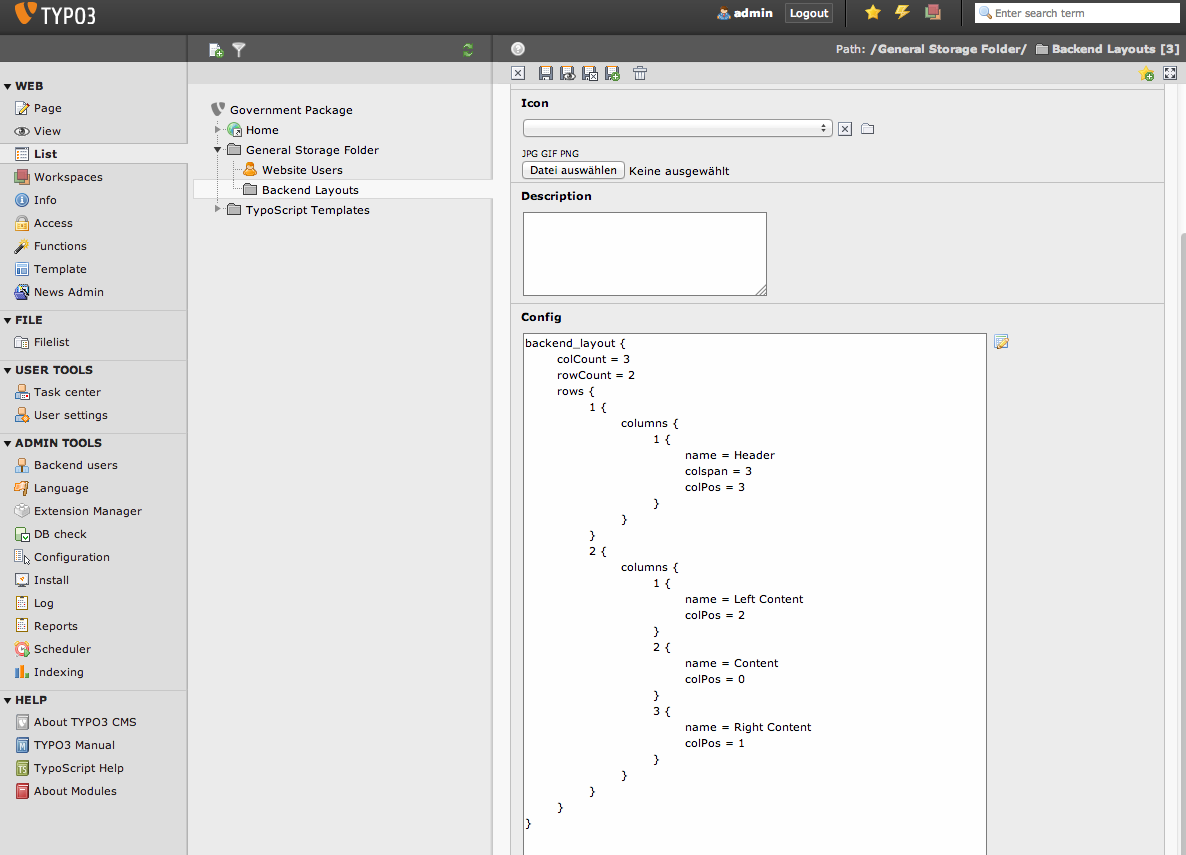
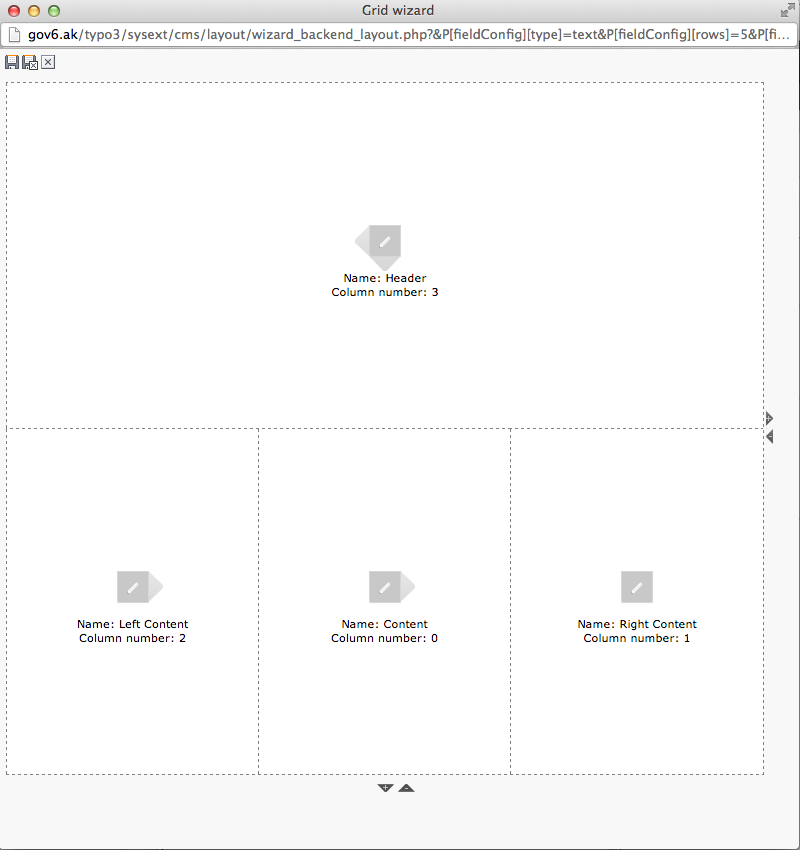
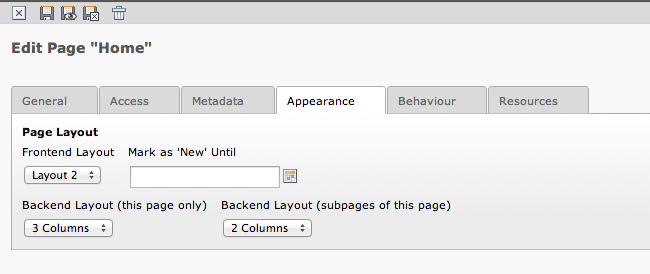
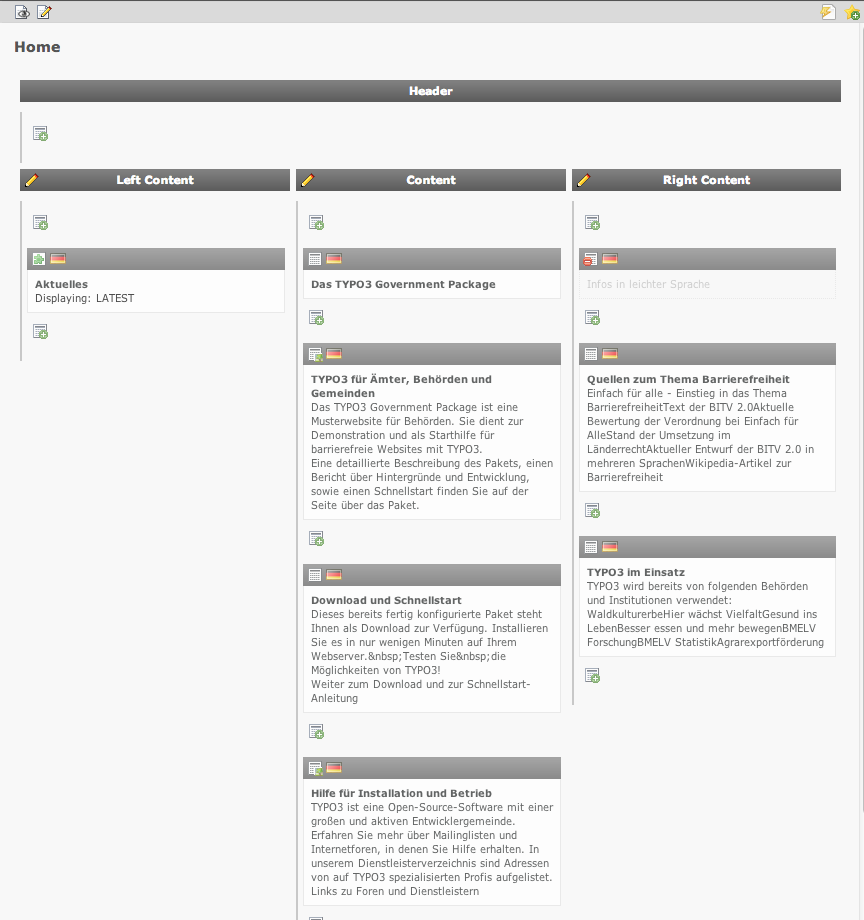
Mehrsprachigkeit? Nichts neues...
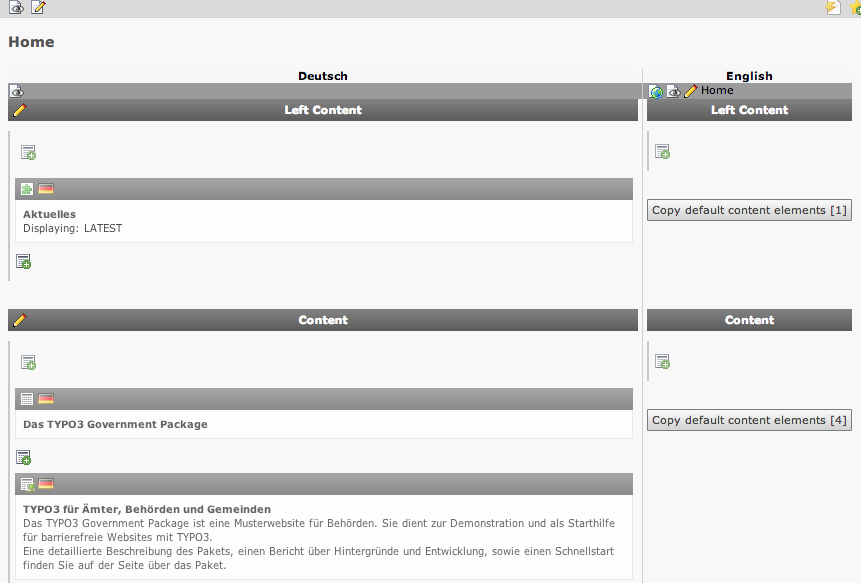
Backend-Layout an das Frontend andocken
page = PAGE
page {
10 = FLUIDTEMPLATE
10 {
layoutRootPath = {$layoutsPath}
file.stdWrap.cObject = CASE
file.stdWrap.cObject {
# slide the template
key.data = levelfield:-1, backend_layout_next_level, slide
key.override.field = backend_layout
# default template file
default = TEXT
default.value = {$templatesPath}/Pages/index.html
# template file for backend-layout with ID 2
2 = TEXT
2.value = {$templatesPath}/Pages/fullcontent.html
}
}Oldschool Template
PAGE.10 = TEMPLATE
PAGE.10 {
template = FILE
template.file.cObject = CASE
template.file.cObject {
key.data = levelfield:-1, backend_layout_next_level, slide
key.override.field = backend_layout
key.append = TEXT
key.append.dataWrap = X{field:layout}
default = TEXT
default.value = fileadmin/templates/default.html
1X0 = TEXT
1X0.value = fileadmin/templates/be_1_fe_default.html
1X1 = TEXT
1X1.value = fileadmin/templates/be_1_fe_1.html
1X2 = TEXT
1X2.value = fileadmin/templates/be_1_fe_2.html
2X0 = TEXT
2X0.value = fileadmin/templates/be_2_fe_default.html
2X1 = TEXT
2X1.value = fileadmin/templates/be_2_fe_1.html
2X2 = TEXT
2X2.value = fileadmin/templates/be_2_fe_2.html
}
}| Backend Layouts | Templavoila |
|---|---|
| + Bordmittel | ~ Separate Extension, (betreut von Core-Dev) |
| + Freie Wahl der Template-Engine | ~ "Alles aus einer Hand" |
| - Konfiguration kann nicht ausgelagert werden | ~ Auslagerung soll funktionieren |
| +++ Kein Mapping updaten nach Template-Änderung | ~ Lebensretter sein, wenn z.B. die Templates gelöscht wurden |
| - Workspaces funktionieren erst seit ein paar Monaten richtig (Änderung von Layouts) | +++ Mit richtigen Einstellungen sind Workspaces kein Problem! |
| - Sprachhandling "unflexibel" | +++ Flexibel, getestet, übersichtlich |
Container-Elemente
| Backend Layouts | Templavoila |
|---|---|
| keine |
nativ vorhanden, beliebige Verschachtelung. Vorsicht bei Mehrsprachigkeit und Workspaces! |
Dafür gibt es Grid-Elements
Alternativen zu Grid Elements
- kb_nescefe → Entwicklung eingeschlafen, Bug in 4.5 mit Security Token nach über einem Jahr behoben!
- fedext/flux → Viel Magie: Aus Fluidtemplate wird Backend-Ansicht und Content-Element mit Flexform generiert
- multicolumn
Grid-Elements
mehr als nur Grids
- Drag&Drop in TYPO3 < 6.0
- kopieren mit Strg-Taste
- neue Elemente anlegen per D&D
- Und bringt auch ein paar neue Bugs mit :-/
- Scheint auch noch einige Probleme mit 6.0 zu haben (Stand vom 22.11)
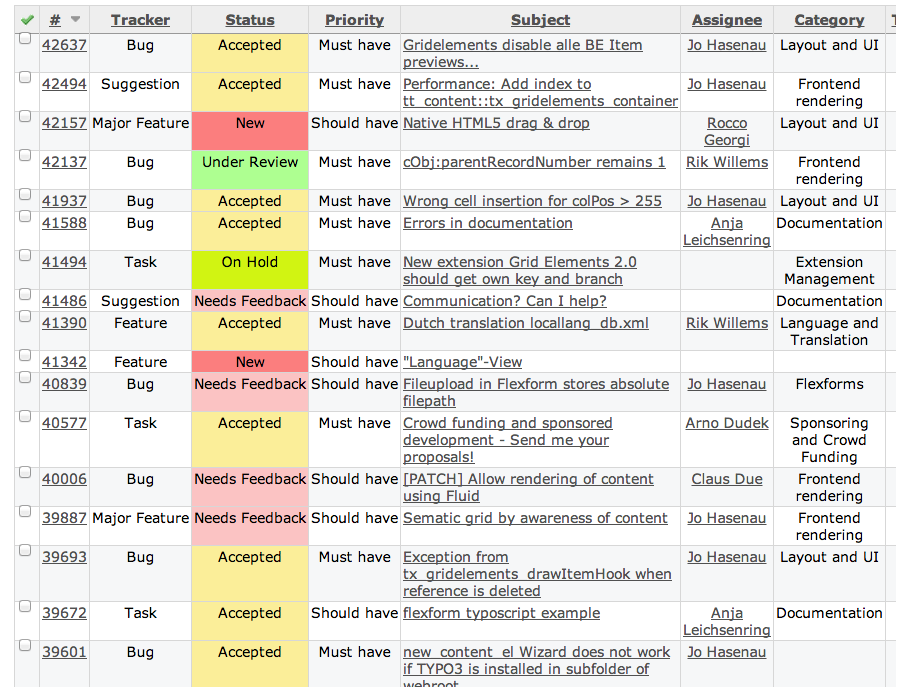
Grid Elements 2.0 - evt. Teil von TYPO3 6.1
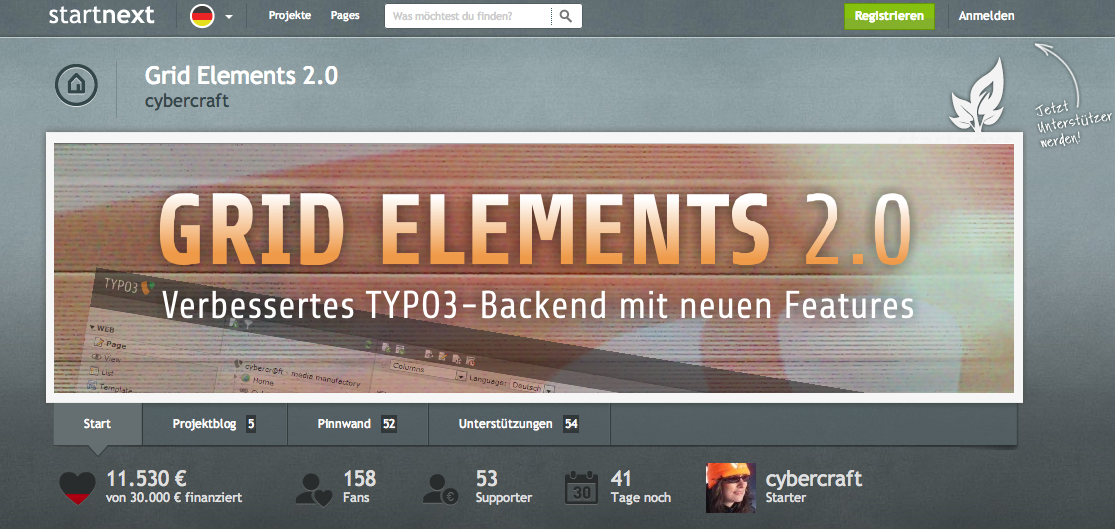 Kein offizielles Core-Projekt?
Kein offizielles Core-Projekt?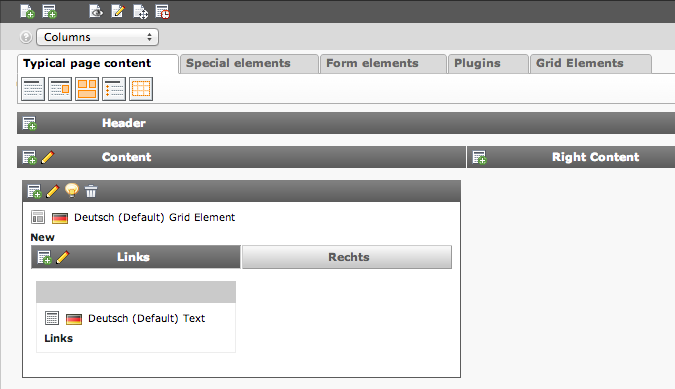
Gleicher Wizard wie bei Backend Layouts
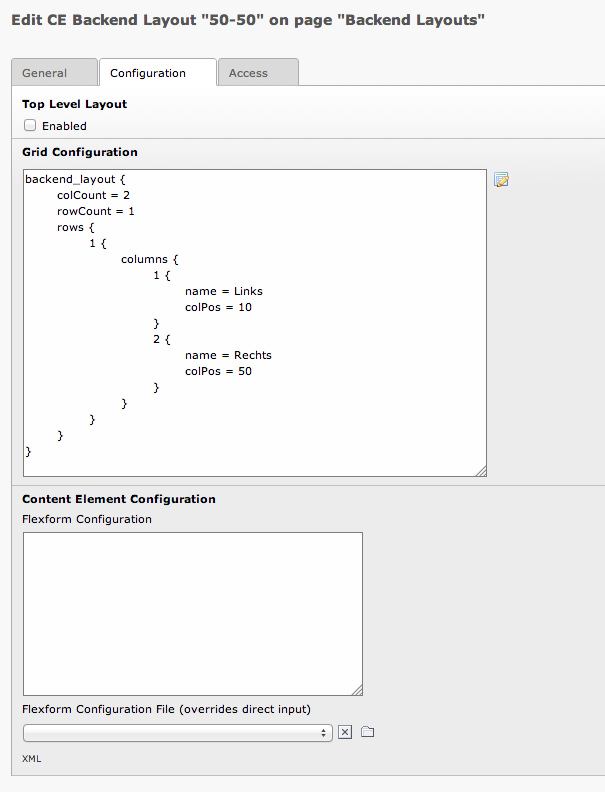
Die Features laut Doku (Auszug)
- Comfortable point and click wizard to create backend layout structures
- Flexforms used for configurational stuff only, can be derived from existing data structures
- Original colPos and sorting fields still working
- Top level layouts to exclude certain types of Grid Elements from being used within other Grid Elements
- Drag & drop move and copy actions for the page module
- New content element wizard overlay to drag in new content elements
- Paste icons for pasting copies and references into grid columns
- Completely TypoScript based frontend output
Wie kriegt man die Ausgabe ins Frontend?
# Gridlayout
tt_content.gridelements_pi1.20.10.setup {
# ID of gridelement
1 < lib.gridelements.defaultGridSetup
1 {
columns {
# colPos ID
50 < .default
50.wrap = <div class="colLeft">|</div>
# colPos ID
51 < .default
51.wrap = <div class="colRight">|</div><div class="clear"> </div>
}
wrap = <div class="contentRow">|</div><div class="clear"> </div>
}
}Unser Fazit:
Für viele Projekte verwendbar, bei komplexeren Projekten (Multilanguage und Workspaces) werden wir nach wie vor auf Templavoila setzenWas packt man in die Backend-Layouts und Grid Elements?
Eigene Content-Elemente
(Bekannte) Frameworks für eigene Content-Elemente
- templavoila: FCEs funktionieren nicht Standalone, sind nur umständlich versionier-/transportierbar, laut Bugtracker viele Probleme mit 4.7
- fedext/flux/fluidcontent: Alles per Fluid Template konfigurierbar, generiert Flexforms, riesige Sammlung an ViewHelpern. Magic?
- dce - Dynamic Content Elements: Elemente werden im Backend per Wizard zusammengeklickt und in DB gespeichert -> keine Versionierung
- wec_contentelements: Einfache API, Datei-Struktur muss Konvention verfolgen
Problem
- zuviel Magie kann und wird bei Updates Schwierigkeiten machen
- was passiert, wenn der Autor keine Lust mehr hat?
-
wir stellen uns aktuell die Frage, wie wir
- kb_nescefe los werden
- sr_feuser_register ersetzen
- gridelements in 6.0 verwenden
- wann Templavoila mit 6.0 kompatibel wird
- Generelles Problem bei Extensions: es kann lange dauern, bis diese mit neuen Versionen verwendet werden können
Dabei ist das gar nicht so schwer
ext_tables.php
$pluginSignature = $extensionName . '_pi1';
$TCA['tt_content']['columns']['CType']['config']['items'][] = array('LLL:EXT:my_ext/Resources/Private/Language/locallang_db.xml:plugin_Pi1', $pluginSignature, '../typo3conf/ext/my_ext/Resources/Public/Images/Icon/pi1.gif');
$TCA['tt_content']['types'][$pluginSignature]['showitem'] = '
--palette--;LLL:EXT:cms/locallang_ttc.xml:palette.general;general,
header, header_layout,
bodytext;LLL:EXT:cms/locallang_ttc.xml:bodytext_formlabel;;richtext:rte_transform[flag=rte_enabled|mode=ts_css], rte_enabled;LLL:EXT:cms/locallang_ttc.xml:rte_enabled_formlabel,
--div--;LLL:EXT:cms/locallang_ttc.xml:tabs.access, --palette--;LLL:EXT:cms/locallang_ttc.xml:palette.visibility;visibility, --palette--;LLL:EXT:cms/locallang_ttc.xml:palette.access;access';TypoScript
tt_content.myext_pi1 = FLUIDTEMPLATE
tt_content.myext_pi1 {
layoutRootPath = {$layoutsPath}
file = {$templatesPath}/Content/text.html
}text.html
<f:if condition="{data.header_layout} == 1">
<h1>{data.header}</h1>
</f:if>
<f:if condition="{data.header_layout} == 2">
<h2>{data.header}</h2>
</f:if>
<f:format.html>{data.bodytext}</f:format.html>Die Daten sind genau so vorhanden, wie sie aus der Datenbank ausgelesen werden.
→ Ideal geeignet für einfachere Strukturen, dank Fluid sind ViewHelper und einfache Kontroll-Strukturen möglich.
Wann reicht das nicht mehr aus:
v.a. bei komplexeren Eingabe-Möglichkeiten, z.B. IRRE-/DB-Relationen im Content-Element
→ Ausweg: Content-Element durch Extbase schicken und die Möglichkeiten von Models nutzen
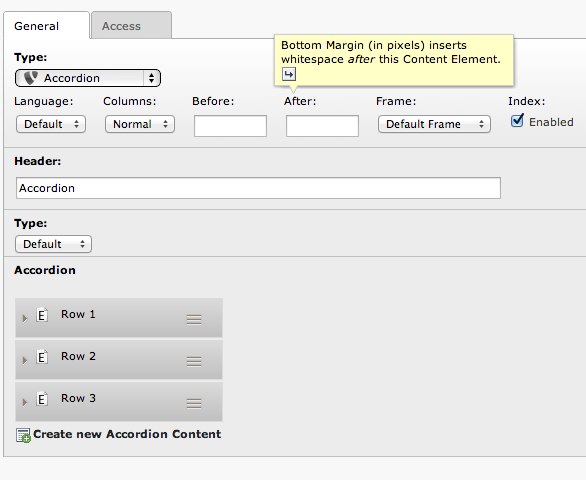
ext_tables.php
$extensionName = 'akaccordion';
\TYPO3\CMS\Extbase\Utility\ExtensionUtility::registerPlugin(
$_EXTKEY,
'Accordion',
'Accordion'
);
\TYPO3\CMS\Core\Utility\ExtensionManagementUtility::addStaticFile($_EXTKEY, 'Configuration/TypoScript', 'Accordion');
$pluginSignature = $extensionName . '_accordion';
$TCA['tt_content']['types'][$pluginSignature]['showitem'] = '
CType;;4;button;1-1-1,
header,
header_layout,
tx_akaccordion_accordion_content,
--div--;LLL:EXT:cms/locallang_ttc.xml:tabs.access, --palette--;LLL:EXT:cms/locallang_ttc.xml:palette.visibility;visibility, --palette
--;LLL:EXT:cms/locallang_ttc.xml:palette.access;access';ext_localconf.php
\TYPO3\CMS\Extbase\Utility\ExtensionUtility::configurePlugin(
'AK.' . $_EXTKEY,
'Accordion',
array('Content' => 'accordion',),
// non-cacheable actions
array(),
\TYPO3\CMS\Extbase\Utility\ExtensionUtility::PLUGIN_TYPE_CONTENT_ELEMENT
);TypoScript
plugin.tx_akaccordion {
persistence.classes {
AK\AkAccordion\Domain\Model\TtContent {
subclasses.akaccordion_accordion = AK\AkAccordion\Domain\Model\Plugins\Accordion
}
AK\AkAccordion\Domain\Model\Plugins\Accordion {
mapping {
recordType = akaccordion_accordion
tableName = tt_content
columns.tx_akaccordion_accordion_content.mapOnProperty = rows
}
}
}
}
config.tx_extbase.persistence.classes {
AK\AkAccordion\Domain\Model\TtContent {
mapping.tableName = tt_content
}
}Eigene Subclasses erhalten weitere Logik (für Conditions) oder die erweiterten Eigenschaften
/**
* Determine, if the content element has videos
*
* @return boolean
*/
public function getHasVideo() {
if ($this->getVideoMp4() || $this->getVideoOgg() || $this->getVideoWebm()) {
return TRUE;
}
return FALSE;
}ak_accordion/Classes/Domain/Model/Plugins/Accordion.php
namespace AK\AkAccordion\Domain\Model\Plugins;
class Accordion extends \AK\AkAccordion\Domain\Model\TtContent {
/**
* @var \TYPO3\CMS\Extbase\Persistence\ObjectStorage<AK\AkAccordion\Domain\Model\AccordionContent>
*/
protected $rows;
/**
* @param \TYPO3\CMS\Extbase\Persistence\ObjectStorage $rows
* @return void
*/
public function setRows($rows) {
$this->rows = $rows;
}
/**
* @return \TYPO3\CMS\Extbase\Persistence\ObjectStorage
*/
public function getRows() {
return $this->rows;
}
}ak_accordion/Classes/Controller/ContentController.php
namespace AK\AkAccordion\Controller;<br>
class ContentController extends \TYPO3\CMS\Extbase\Mvc\Controller\ActionController {
/**
* @return void
*/
public function accordionAction() {
$data = $this->configurationManager->getContentObject()->data;
$this->view->assign('content', $this->contentRepository->findByUid($data['uid']));
}ak_accordion/Resources/Private/Templates/Content/Accordion.html
<div class="accordion">
<f:for each="{content.rows}" as="row">
<h3>{row.head}</h3>
<div>
<f:if condition="{row.image}">
<div style="float: left; padding-right: 10px;">
<f:image src="uploads/tx_akaccordion/{row.image}" alt="" maxWidth="160" maxHeight="80" />
</div>
</f:if>
<f:format.nl2br>{row.bodytext}</f:format.nl2br>
</div>
</f:for>
</div>Wenn das ganze jetzt noch in den Wizard soll
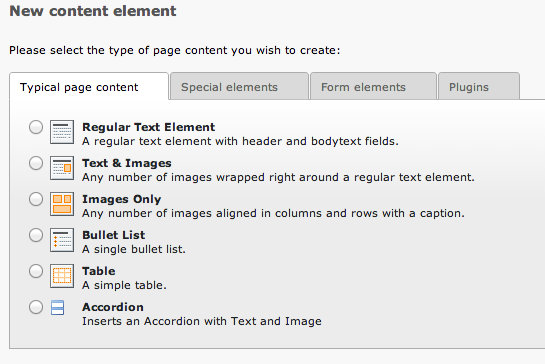
ext_localconf.php
t3lib_extMgm::addPageTSConfig('<INCLUDE_TYPOSCRIPT: source="FILE:EXT:' . $_EXTKEY . '/Configuration/TsConfig/PageTs/wizard.ts">');wizard.ts
mod.wizards.newContentElement.wizardItems.common.elements.ak_accordion {
icon = ../typo3conf/ext/ak_accordion/Resources/Public/Icons/Wizard/plugin_accordion.png
title = LLL:EXT:ak_accordion/Resources/Private/Language/locallang_wizard.xlf:plugin_accordion
description = LLL:EXT:ak_accordion/Resources/Private/Language/locallang_wizard.xlf:plugin_accordion_description
tt_content_defValues {
CType = akaccordion_accordion
}
}
mod.wizards.newContentElement.wizardItems.common.show := addToList(ak_accordion)Hier gibts die Extension:
https://github.com/akiessling/ak_accordionWeiterführende Links
- http://fedext.net/
- http://blog.mittwald.de/cms/responsive-typo3-3-backend-layouts-und-grid-elements/
-
Der Weg weg von Templavoila
http://vimeo.com/41665329 - Content-Element Wizard: http://buzz.typo3.org/people/steffen-kamper/article/the-new-content-element-wizard-in-version-43/